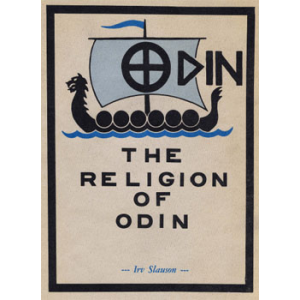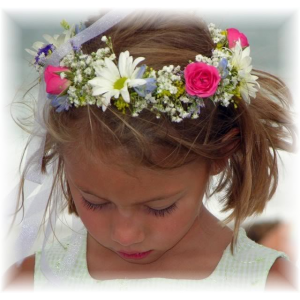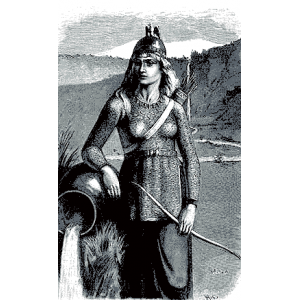
Scholars are as sure as they can be that Bertha, Perchta and Huldra were different names in different places for the same goddess. The names and
Traditions also seem to all be descended from the traditions of Nerthus, the oldest birch goddess (or Eartha or Jordh as her name is given elsewhere). So what do all these birch goddesses have in common? What things do we know that would, when put together, enlarge our
Information of the birch goddess?
1)All these goddesses have processions. Huldra, Bertha, and Perchta are said to lead the Wild Hunt. Nerthus has her twice yearly processions to bring fertility to the earth.
2)All are birch goddesses. All have functions related to fertility.
3)Huldra's procession includes the huldrafolk, land-wights. Odin's Wild Hunt is said, in many, many traditions, to be hunting the huldrafolk, or hunting alfs, in an effort to eradicate all of them. These land-wights are often identified with plant-life.
4)Odin's Wild Hunt includes hounds or wolves. One of the most common elements associated with birch goddesses is the hound or wolf. In both these cases this is because there is a close symbolic
Connection with the hound or wolf and the dead.
5)Bertha and Perchta are spoken of as goddesses of those not yet born.
Putting all these elements together gives us the following picture:
The birch goddess is the earth, married to Odin. At the break of summer, at May Day, she brings forth life on the earth. She processes, travelling across the earth to do this, following after Odin. But all things die, and the harvest must come at last. At this time her consort, Odin goes amongst the dead. When harvest happens, the birch goddess has nothing more to give. Then the spirits she brings to the earth are dead, and have no benefit for mankind. This must be why Odin seeks to kill them, and only does so during the winter. He is the psychopomp, and they must be brought back to the realms of the dead, and as Drighten of Draugs he leads the forces of the dead on a hunt across the earth, seeking the birch goddess and her people, to bring them where they belong. This is the meaning of the leading position of the Wild Hunt given as both Odin and the birch goddess. Odin is Master of the Hunt. The birch goddess is its quarry. At this time of year she also takes Ullr as lover, as he is god of winter. He eventually overtakes them, and kills them. Then it is the goddess who descends into the world of death. She is reborn (possibly due again to Odin's aid, as psychopomp). She is then the nourisher of life again, and as mother of the unborn and, by extension, of reincarnation, she can bring back her folk as crops and trees and grasses again. She is then in a position to bring Odin back, and take him again as consort.
This reconstruction certainly fits everything we know of the birch goddess(es). It is also consistent with many other Indo-European traditions, which involve a yearly descent of a goddess into the underworld (such as Persephone or Innana). Myself, I worship the birch goddess as Nerthus, wife of Odin (and Ullr alternately), sometimes chasing him, sometimes fleeing him. This gives me a whole picture that relates Odin, Nerthus, the year, the crops, other gods, the dead, etc. into one story. It may never have been practiced exactly this way by anyone at anytime. But I think it does reflect accurately an assortment of practices. And our tradition is living, not dead. It changes as the world does, as our cultures do.
Free eBooks (Can Be Downloaded):
Zoroaster - The Chaldean OraclesEa Wallis Budge - The Egyptian Heaven And HellEmmanuel Swedenborg - Heaven And HellEdward Hare - Bewitched And Bothered
 The original meaning of Berkana is birch. The birch still has a similar name in Scandinavian languages: in Norwegian it's bjork, in Swedish bjork, birk in Danish, birki in Icelandic. Seeing how the birch is a female plant, this Rune is connected to the female energy and female deities like Frigga and Idun. Berkana is the Rune of regeneration, fertility, birth and health, as attested by the Runic poem describing Berkana as a young and healthy tree. The quality of Berkana is connected to everything that's new, young or just growing, whether it's a new tree or a newborn. Fertility is also connected to the process of birth and creating something new, so Berkana can symbolize a new addition to the family or an emerging thought being born in the mind of a scientist or artist. As the Rune of health, Berkana is most often used as a talisman that brings health back to the sick. Beside that, it can also be used for protection, because in the olden days it was planted in front of a house to provide protection to the residents (in Slavic folklore it's the service tree that's planted in front of a house for protection).
The original meaning of Berkana is birch. The birch still has a similar name in Scandinavian languages: in Norwegian it's bjork, in Swedish bjork, birk in Danish, birki in Icelandic. Seeing how the birch is a female plant, this Rune is connected to the female energy and female deities like Frigga and Idun. Berkana is the Rune of regeneration, fertility, birth and health, as attested by the Runic poem describing Berkana as a young and healthy tree. The quality of Berkana is connected to everything that's new, young or just growing, whether it's a new tree or a newborn. Fertility is also connected to the process of birth and creating something new, so Berkana can symbolize a new addition to the family or an emerging thought being born in the mind of a scientist or artist. As the Rune of health, Berkana is most often used as a talisman that brings health back to the sick. Beside that, it can also be used for protection, because in the olden days it was planted in front of a house to provide protection to the residents (in Slavic folklore it's the service tree that's planted in front of a house for protection).



